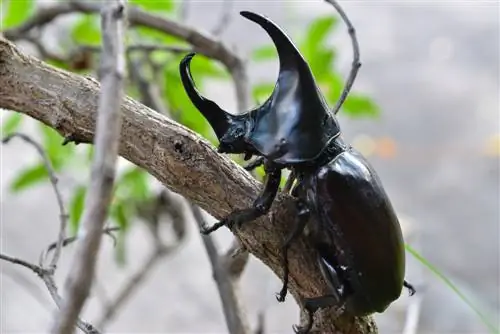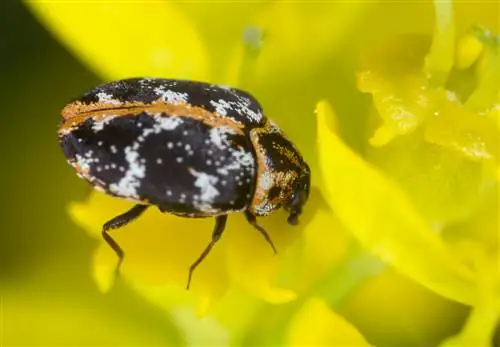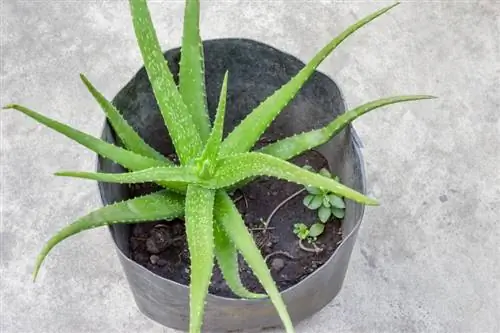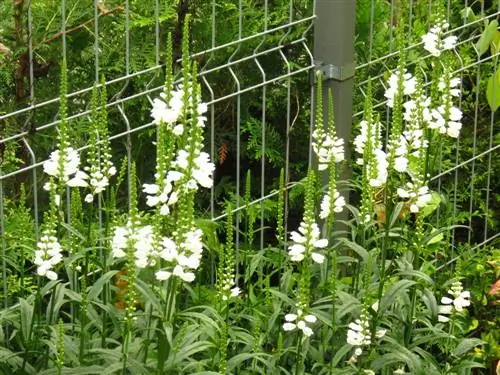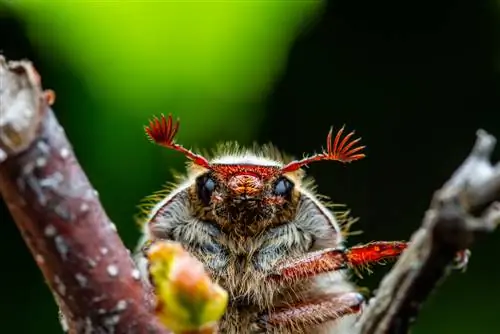- Author admin [email protected].
- Public 2023-12-16 16:46.
- Last modified 2025-06-01 06:02.
Admiring a real rhinoceros beetle is something only a few hobby gardeners are able to do. The prospect of discovering an impressive rhinoceros beetle larva in the compost is much greater. In fact, the presence of giant beetles and fat grubs is an accolade for the nature-loving gardener. Read everything you need to know about rhinoceros beetles here with practical tips on how to keep them properly.
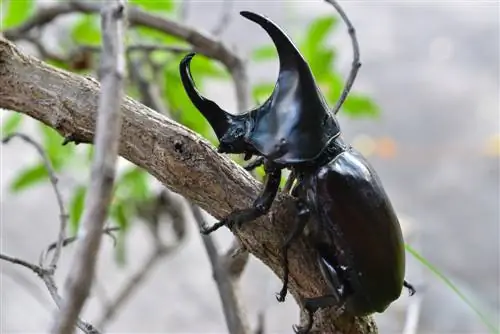
Rhinoceros beetle larva - interesting facts about the grubs

Rhinoceros beetle larvae are a blessing for any compost
Every discovery of a rhinoceros beetle larva in the compost is an unmistakable indication of the high ecological value of the garden. Female rhinoceros beetles are very picky when choosing a biotope or compost heap as a nursery. The ecological balance must be right and all conditions must be right for expectant beetle mothers to even consider a garden as a larval habitat. Accordingly, amateur gardeners rarely experience a close encounter with the precious natural treasures. The following table summarizes important information and identifying characteristics of a rhinoceros beetle larva:
| average information | |
|---|---|
| Size | 8 to 12 cm |
| color | whitish to cream colored |
| Body shape | roll-shaped |
| Posture | C-shaped curved |
| Front area | brown head capsule, 3 long legs |
| Surface | segmented |
| Lifespan | 3 to 5 years |
| habitat | Compost, wood pulp, wood cuttings |
| Food | Cellulose, wood fibers, fibrous material |
| protected | yes |
| critically endangered | no |
Have you discovered larvae in the compost and identified them as rhinoceros beetle grubs? Then it is not possible to distinguish between males and females in this development phase. Only when a larva has pupated and transformed into an adult rhinoceros beetle do clear distinguishing features become apparent. Further information on gender determination is provided in the profile below.
Female rhinoceros beetle - information about a miracle of nature
Female rhinoceros beetles have to hurry because time is limited to find a suitable male and the ideal location to lay their eggs. After hatching as a finished beetle, its lifespan extends to four to six weeks. As a rule, rhinoceros beetles remain in the cocoon the size of a chicken egg for some time and wait until the flight season begins at the end of May. At dusk, females and males finally leave their previous home and embark on their nuptial flight.
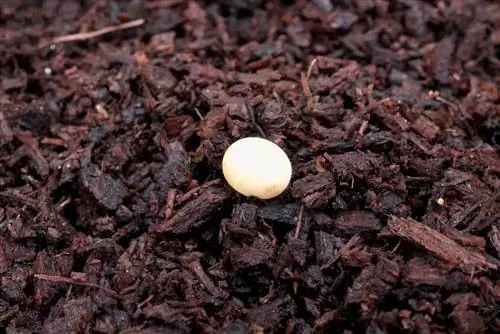
Rhinoceros beetle eggs are amazingly large
Critically, female rhinoceros beetles select the strongest male as the father of their offspring. Only those who are victorious against all rivals are allowed to mate with a female. Egg laying takes place in midsummer. Beforehand, the female beetle carefully examines possible locations. Quiet gardens with a he althy ecosystem are shortlisted as nurseries. Properly constructed compost heaps with plenty of decomposed wood fibers have the best chance of being ideal food for larvae.
Female rhinoceros beetles no longer care about the approximately 30 eggs that have been laid and the resulting larvae. The rotting process in the compost creates sufficiently high temperatures for the grubs to develop he althily. Immediately after laying their eggs, the female beetles have fulfilled their life's task and die. As a rule, the males have already ended their short and intense lives some time before.
Buy a rhinoceros beetle - is that possible?
In Germany, rhinoceros beetles are an endangered species subject to the Federal Nature Conservation Act. According to § 44 BNatSchG, it is prohibited under pen alty of law to catch, injure or even kill the larvae and beetles. Furthermore, their natural habitat must not be destroyed in order to ensure unhindered development. In connection with this, it is strictly forbidden to take, buy or sell rhinoceros beetle larvae or beetles from nature. The need for protection of the rare beetles is underlined in most federal states by the fact that rhinoceros beetles are listed on the Red List.
In Germany you will not find any reputable dealers or legal purchasing sources for rhinoceros beetles or their larvae. For good reason, because failure to comply with the legal protection regulations will result in fines of up to 50.000 euros fined. Please ignore illegal online purchase offers on free classified ad portals from pseudo pet dealers. The joy over the temptingly low price for a rhinoceros beetle doesn't last long, because in the worst case scenario you'll end up with a hefty bill for the fine.
Excursus
Japanese rhinoceros beetle - giant from Asia
Japanese rhinoceros beetle with the scientific name Allomyrina dichotomus is only distantly related to the European common rhinoceros beetle (Oryctes nasicornis). Both beetle species belong to the family of scarab beetles (Scarabaeidae), but they go their separate ways in terms of genus, size and distribution area. Allomyrina dichotomus is considered the largest beetle in Japan, measuring an impressive length of up to 5.4 centimeters. Males boast a massive, forked horn that grows up to 2.5 centimeters long. In contrast to Germany, the trade in rhinoceros beetles is traditionally permitted in Japan and represents a flourishing business for pet shops.
Rhinoceros Beetle Keeping - Instructions for the Garden
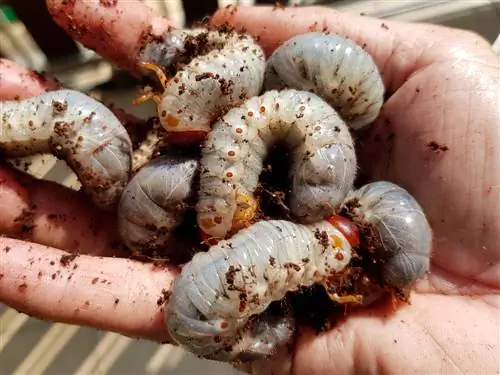
Rhinoceros beetles appear on their own in he althy compost
Keeping rhinoceros beetles is closely linked to the strict provisions of the Federal Nature Conservation Act. Buying or otherwise taking possession is not permitted. Animal-loving and environmentally conscious home gardeners do not consider this option anyway because keeping rhinoceros beetles as pets is against nature and involves a high level of stress for the animals. By managing the garden organically and creating perfect compost, you promote it as an ideal habitat for female rhinoceros beetles. The following criteria should be taken into account for competent rhinoceros beetle keeping in the garden:
Toxic-free gardening
Female rhinoceros beetles approaching immediately turn away when they smell pesticides and other environmental toxins. However, those who have been practicing poison-free gardening in their green kingdom for several years are in favor of the expectant beetle mothers. We have compiled the most important cornerstones for a natural garden for you below:
- No use of chemical insecticides, weed killers and other pesticides
- varied planting with native wildflowers, grasses and perennials
- Nutrification of plants with organic fertilizers (compost, plant manure)
- Fight diseases and pests with home remedies (lice with soap solution, mildew with milk and water)
Female rhinoceros beetles have a soft spot for natural gardens with native trees and bushes. Knowing full well that the offspring like to eat decomposing wood. Do not throw away clippings, even if the amount is too large for compost. Simply pile up leaves, small branches and chopped twigs in a quiet garden niche. Not only female beetles can resist this invitation. Other beneficial insects are happy about the retreat, like hedgehogs.
Make compost beetle-friendly
The compost heap plays a key role in a rhinoceros beetle-friendly garden. Scarab beetles have long since conquered small and large home gardens as potential larval habitat. Long-term field observations by interested entomologists have proven that properly created compost is at the top of the ranking of suitable locations for laying eggs. The following list contains the fundamental framework conditions for a compost as a nursery for rhinoceros beetle grubs:
- partly shaded to shady location, preferably under the canopy of trees or large bushes
- direct ground contact for unhindered digging activities
- Covering the floor with a vole screen to protect against moles
- create a lower layer made of coarse materials, such as perennial or tree cuttings
- fill with a variety of uncooked kitchen waste and shredded garden waste
- preferably use straw, leaves or bedding as intermediate layers
The more decomposing cellulose is used, the richer the food for rhinoceros beetle grubs in the compost. Shredded wooden furniture is only suitable for composting if it does not contain any chemical stains, varnishes or paints. Paper is only an option as food for hungry rhinoceros beetle larvae in the compost if it is not printed newspaper or even leftover glossy magazines.
Take care of the compost heap properly
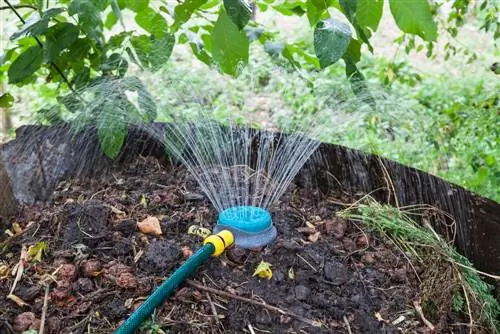
If there is a lot of drought, the compost heap should be watered
Constant moisture is vital for keeping rhinoceros beetles in compost. The fat grubs in particular depend on a regular supply of water. On hot, dry summer days, please visit the compost heap and its inhabitants with a watering can or garden hose. Additionally, cover the organic material with breathable compost fleece.
Stop turning compost with larvae
Larvae are usually discovered in compost when the organic material is converted and sieved to supply oxygen. After a discovery, please modify the care of the compost heap, tailored to the special conditions for the habitat and species protection of rhinoceros beetles. Collect the screened out larvae by hand. Place the natural jewels on the half-ripened compost heap as quickly as possible. Please place cocoons or adult beetles in waiting positions for the upcoming flight time on the sifted material so that they can free themselves more easily. From now on, the compost heap in question should no longer be moved or sieved. Instead, set up a second compost site that will provide you with natural fertilizer from now on.
Keeping runner ducks and rhinoceros beetles on one property does not end well for the beetles and larvae. The prey pattern of Indian ducks does not only include slugs. Undeterred, the funny snail hunters destroy a valuable rhinoceros beetle grub. So that you don't have to choose between the two natural treasures, simply fence in the compost area. Runner ducks are flightless water birds and respect a fence of at least 150 centimeters as their territory boundary.
Distinct between male and female rhinoceros beetles
Male rhinoceros beetles are primarily used to show off their characteristic horn when they impress rivals or compete with them in combat. Furthermore, the beetle lords proudly present the mighty rhinoceros when they vie for the favor of their beloved. Females only display a mini horn. Of course, horn size and shape are not the only attributes of the giant beetles. The following profile summarizes important characteristics of rhinoceros beetles with information on sex determination:
- Insect family: Scarab beetle (Scarabaeidae)
- Genus and species: Species within the genus giant beetle (Oryctes nasicornis)
- Areas of distribution: Central and Southern Europe, North Africa, Central and East Asia
- Beetle size: 20 to 40 mm
- Beetle body: cylindrical, dark brown, shiny chestnut-brown elytra, hairy underneath
- male horn: large, 10 mm long, backwards curved horn on the top of the head
- female horn: small, inconspicuous bump
- Neck shield male: strip-shaped elevation at the back, three bent-up humps in the middle
- Protect female: smooth, without noticeable bumps
- Lifespan as an imago: 4 to 6 weeks
- Sleep-wake rhythm: crepuscular, nocturnal

With an ingenious survival strategy, rhinoceros beetles in Germany and Europe have adapted their habitat. The giant beetles originally lived in the forests that covered our continent. Beetles and grubs prefer to make themselves comfortable in dead tree trunks and thick branches of old trees. In the course of human settlement activities and the associated decline of forest areas, the clever survival artists followed humans. As cultural followers, rhinoceros beetles have now discovered private gardens, parks and biotopes as a new habitat.
Male rhinoceros beetle without horn
Small male rhinoceros beetles use an ingenious strategy to still win over the females. Since the beetle tots would be hopelessly outnumbered in battle, they simply forego an impressive rhinoceros. At first glance, the masters of camouflage look very similar to a female rhinoceros beetle. The cunning strategists use this advantage and smuggle themselves undetected among the ladies. While large males engage in fierce fights, the smaller males mate calmly with the females.
Tip
An encounter with rhinoceros beetles is primarily granted to home gardeners in eastern German states and in mild lowlands. Due to the very different distribution of giant beetles in Germany, the discovery of rhinoceros beetle larvae in compost is considered a horticultural sensation in western federal states. The situation is comparable to ladybird larvae, which occur locally in larger numbers and are extinct in some regions.
Frequently asked questions
We found rhinoceros beetle larvae in the compost. What to do?
Happy about the find, because you did everything right as an environmentally friendly gardener. It takes a lot of rest and even more patience until the fat grubs transform into magnificent rhinoceros beetles. The lifespan from larva to imago extends over three to five years. During this time, pay attention to important conditions when making compost, such as constant moisture and direct contact with the soil. Do not turn over the compost heap again. You should immediately put the sifted out rhinoceros beetle larvae back into half-ripened compost so that they can quickly burrow in.
What do rhinoceros beetles eat?
A rhinoceros beetle larva feeds mainly on rotting wood, such as cuttings from trees and bushes, sawdust or bark mulch. The preferred habitat of larvae is the compost heap in the natural garden if it contains plenty of fibrous material that has not come into contact with pesticides or similar toxins. Whether adult female or male rhinoceros beetles eat at all during their short lives is a matter of controversy among experts. The magnificent beetles probably cover their energy needs from tree sap. Fresh greenery, such as flowers, vegetable plants or perennials, is therefore not on the menu of the giant beetles.
Can rhinoceros beetles fly?
Rhinoceros beetle larvae go through a two to five year development phase before emerging from their cocoon as adult beetles. For a short lifespan of four to six or seven weeks, females and males can fly so they can find each other and mate. The main flight season is from the end of May to the beginning/mid-June, preferably at dusk.
Are rhinoceros beetle larvae dangerous for plants in the garden?
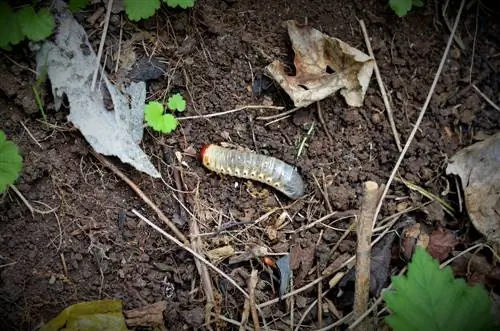
Rhinoceros beetle larvae clean up the garden and ensure good soil quality
Rhino horn beetle larvae feed primarily on dead wood, decomposing cellulose or bark mulch. Thanks to a special intestinal flora, the grubs can easily digest the tough material that other insects get stuck in their throats. The larvae disdain living plant material from flowers, perennials or vegetables. There is therefore no reason to take countermeasures if rhinoceros beetle larvae are found in the compost.
While sifting compost, we came across a huge cocoon in which a rhinoceros beetle is probably growing. How should we proceed now?
Between the ages of 3 and 5, rhinoceros beetles have gone through all three larval stages. The grubs then pupate in cocoons the size of a chicken egg, which they assemble themselves from sawdust, cellulose and clay. The young beetles remain in a cocoon until they hatch and begin their nuptial flight at the end of May/beginning of June. Carefully take the cocoon in your hand and place it a few centimeters deep into the sifted compost soil. The finer material makes it easier for the beetles to hatch and leave. Postpone using the natural fertilizer in the garden until the rhinoceros beetles have left the pile.
How long does a rhinoceros beetle live?
An adult rhinoceros beetle is not granted a short life of four to six weeks. The development from egg to adult beetle, however, takes up to five years, consisting of three larval stages and a pupation in the cocoon. The fully formed rhinoceros beetles hatch in late spring and remain in the protective cocoon for some time. At the end of May/beginning of June, males and females fly out to provide for offspring. The rhinoceros beetles die by the end of July/beginning of August at the latest.
Where can you buy a Japanese rhinoceros beetle? How much does a live beetle cost?
In Japan there is a real hype about the Japanese rhinoceros beetle, also known as the samurai beetle. Traditionally, Japan's largest beetle species is one of the most popular pets. Most pet stores carry Allomyrina dichotomus or a subspecies in their standard selection. In Germany, a few exotic beetle dealers offer live Japanese rhinoceros beetles and their larvae for sale. The price for a live beetle is 10 to 12 euros. Third instar larvae cost around 8 euros. Since the Asian beetle species is not native to Germany, it is not subject to the Federal Nature Conservation Act.
Tip
Rhinoceros beetles are considered the weightlifters in the beetle kingdom. In fact, scientists recognize jewel beetles as the world's strongest animal species based on their relative weight. Adult females and fully developed males can lift 850 times their body weight. If a person wanted to keep up with this, they would have to shoulder a whopping 55 tons.

